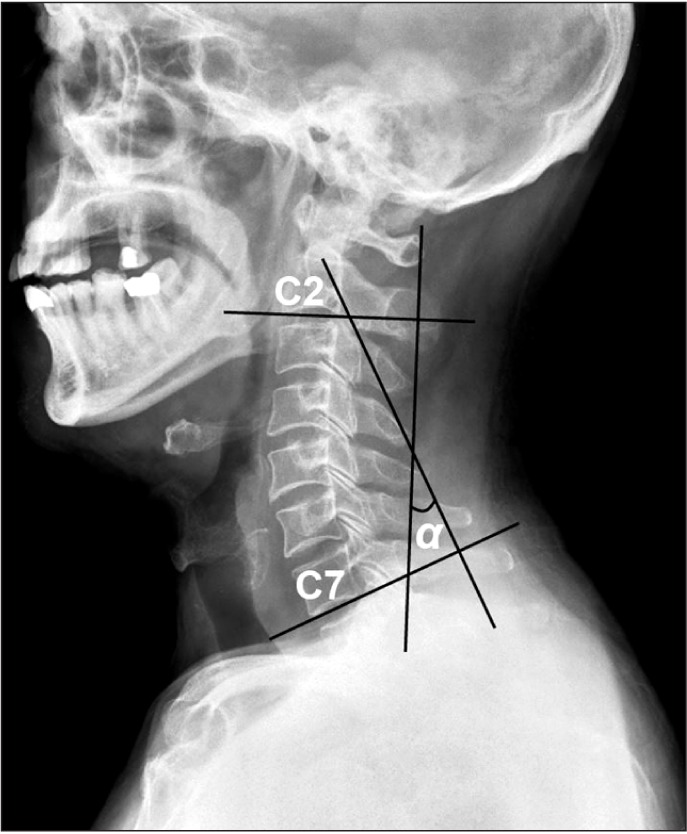Ann Rehabil Med.
2016 Oct;40(5):816-825. 10.5535/arm.2016.40.5.816.
Effects of Cervical Kyphosis on Recovery From Dysphagia After Stroke
- Affiliations
-
- 1Department of Rehabilitation Medicine, Dong-Eui Medical Center, Busan, Korea.
- 2Department of Physical Medicine and Rehabilitation, Ulsan University Hospital, University of Ulsan College of Medicine, Ulsan, Korea. tikira@naver.com
- KMID: 2382913
- DOI: http://doi.org/10.5535/arm.2016.40.5.816
Abstract
OBJECTIVE
To determine the effects of cervical kyphosis on the recovery of swallowing function in subacute stroke patients.
METHODS
Baseline and 1-month follow-up videofluoroscopic swallowing studies (VFSSs) of 51 stroke patients were retrospectively analyzed. The patients were divided into the cervical kyphosis (Cobb's angle <20°, n=27) and control (n=24) groups. The penetration-aspiration scale (PAS), American Speech-Language-Hearing Association National Outcomes Measurement System swallowing scale (ASHA NOMS), and videofluoroscopic dysphagia scale (VDS) were used to determine the severity of dysphagia. Finally, the prevalence of abnormal VFSS findings was compared between the two groups.
RESULTS
There were no significant differences in baseline PAS, ASHA NOMS, and VDS scores between the two groups. However, the follow-up VDS scores in the cervical kyphosis group were significantly higher than those in the control group (p=0.04), and a follow-up study showed a tendency towards worse ASHA NOMS scores (p=0.07) in the cervical kyphosis group. In addition, the cervical kyphosis group had a higher occurrence of pharyngeal wall coating in both baseline and follow-up studies, as well as increased aspiration in follow-up studies (p<0.05).
CONCLUSION
This study showed that stroke patients who had cervical kyphosis at the time of stroke might have impaired recovery from dysphagia after stroke.
MeSH Terms
Figure
Reference
-
1. Papadopoulou S, Exarchakos G, Beris A, Ploumis A. Dysphagia associated with cervical spine and postural disorders. Dysphagia. 2013; 28:469–480. PMID: 23959456.
Article2. Kauffman T. Posture and age. Top Geriatr Rehabil. 1987; 2:13–28.
Article3. Han K, Lu C, Li J, Xiong GZ, Wang B, Lv GH, et al. Surgical treatment of cervical kyphosis. Eur Spine J. 2011; 20:523–536. PMID: 20967471.
Article4. Rhee JM. Iatrogenic cervical deformity. Semin Spine Surg. 2011; 23:173–180.
Article5. Goyal N, Narlawar R, Garrett A. Kyphosis, a rare cause of dysphagia. Age Ageing. 2005; 34:521–522. PMID: 16107461.
Article6. Crary MA. Adult neurologic disorders. In : Groher ME, Crary MA, editors. Dysphagia: clinical management in adults and children. Maryland Heights: Mosby;2009. p. 72–98.7. Veis SL, Logemann JA. Swallowing disorders in persons with cerebrovascular accident. Arch Phys Med Rehabil. 1985; 66:372–375. PMID: 4004534.8. Freeman BL III. Scoliosis and kyphosis. In : Canale ST, Beatty JH, editors. Campbell's operative orthopaedics. 10th ed. St. Louis: Mosby;2003. p. 1751–1954.9. Harrison DE, Harrison DD, Cailliet R, Troyanovich SJ, Janik TJ, Holland B. Cobb method or Harrison posterior tangent method: which to choose for lateral cervical radiographic analysis. Spine (Phila Pa 1976). 2000; 25:2072–2078. PMID: 10954638.10. Logemann JA. Evaluation and treatment of swallowing disorders. 2nd ed. Austin: Pro-Ed;1998.11. Rosenbek JC, Robbins JA, Roecker EB, Coyle JL, Wood JL. A penetration-aspiration scale. Dysphagia. 1996; 11:93–98. PMID: 8721066.
Article12. American Speech-Language-Hearing Association. National Outcomes Measurement System (NOMS): adult speech-language pathology user's guide. Rockville: American Speech-Language-Hearing Association;2003.13. Jung SH, Lee KJ, Hong JB, Han TR. Validation of clinical dysphagia scale: based on videofluoroscopic swallowing study. J Korean Acad Rehabil Med. 2005; 29:343–350.14. Todd AG. Cervical spine: degenerative conditions. Curr Rev Musculoskelet Med. 2011; 4:168–174. PMID: 22021015.
Article15. Griegel-Morris P, Larson K, Mueller-Klaus K, Oatis CA. Incidence of common postural abnormalities in the cervical, shoulder, and thoracic regions and their association with pain in two age groups of healthy subjects. Phys Ther. 1992; 72:425–431. PMID: 1589462.
Article16. Matz PG, Wolff CL III, Hadley MN. Management of cervical kyphotic deformity. Semin Neurosurg. 2003; 14:55–60.17. Janda V. Muscle and motor control in cervicogenic disorders. In : Grant R, editor. Physical therapy of the cervical and thoracic spine. 3rd ed. New York: Churchill Livingstone;2002. p. 182–199.18. Watson DH, Trott PH. Cervical headache: an investigation of natural head posture and upper cervical flexor muscle performance. Cephalalgia. 1993; 13:272–284. discussion 232. PMID: 8374943.
Article19. Johnson J. Postural correction. . Champaign: Human Kinetics;2015.20. Logemann JA, Rademaker A, Pauloski BR, Kelly A, Stangl-McBreen C, Antinoja J, et al. A randomized study comparing the Shaker exercise with traditional therapy: a preliminary study. Dysphagia. 2009; 24:403–411. PMID: 19472007.
Article21. Mepani R, Antonik S, Massey B, Kern M, Logemann J, Pauloski B, et al. Augmentation of deglutitive thyrohyoid muscle shortening by the Shaker Exercise. Dysphagia. 2009; 24:26–31. PMID: 18685891.
Article22. Mishra A, Rajappa A, Tipton E, Malandraki GA. The recline exercise: comparisons with the head lift exercise in healthy adults. Dysphagia. 2015; 30:730–737. PMID: 26386974.
Article23. Falla DL, Jull GA, Hodges PW. Patients with neck pain demonstrate reduced electromyographic activity of the deep cervical flexor muscles during performance of the craniocervical flexion test. Spine (Phila Pa 1976). 2004; 29:2108–2114. PMID: 15454700.
Article24. Cagnie B, Dickx N, Peeters I, Tuytens J, Achten E, Cambier D, et al. The use of functional MRI to evaluate cervical flexor activity during different cervical flexion exercises. J Appl Physiol (1985). 2008; 104:230–235. PMID: 17991788.
Article25. Don Kim K, Lee HJ, Lee MH, Ryu HJ. Effects of neck exercises on swallowing function of patients with stroke. J Phys Ther Sci. 2015; 27:1005–1008. PMID: 25995543.
Article26. Harrison DD, Jackson BL, Troyanovich S, Robertson G, de George D, Barker WF. The efficacy of cervical extension-compression traction combined with diversified manipulation and drop table adjustments in the rehabilitation of cervical lordosis: a pilot study. J Manipulative Physiol Ther. 1994; 17:454–464. PMID: 7989879.27. Ferrantelli J. BioPhysics insights: the Denneroll orthotic. Am J Clin Chiroprac. 2010; 20:13–14.
- Full Text Links
- Actions
-
Cited
- CITED
-
- Close
- Share
- Similar articles
-
- Epidemiology, Natural Recovery, Long-term Outcome of Post Stroke Dysphagia
- Natural Course of Swallowing Recovery and Associated Factors in Post-Ischemic Stroke Dysphagia
- Post-Stroke Dysphagia: Incidence, Complications and Pattern Relates to Brain Lesion
- Improvement of Dysphagia after Anterior Cervical Screw Removal: Case Report
- Prognostic Indicators in Dysphagia Recovery


